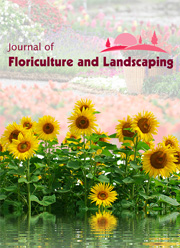Impact of water deficit stress on biomass production of different gladiolus cultivars under rainfed condition
DOI:
https://doi.org/10.25081/jfcls.2015.v1.2806Abstract
Among the environmental stresses, water deficit stress was recognized to be one of the most adverse factors for plant growth and productivity. The study aimed to comparatively evaluate impact of water deficit stress on biomass of seven cultivars of gladiolus in terms of leaf area duration and net assimilation rate under rainfed conditions in northeastern region of India. Also, productions in terms of marketable spikes were compared. The parameters were measured using standard procedures. Comparatively higher leaf area duration (116 days) and net assimilation rate were found in cultivars Aarti (116 days and1.62 gcm-2day-1x10-3 respectively) and Suchitra (98.0 days and 1.10 gcm-2day-1x10-3) which account for their higher biomass production with larger spike size with good numbers of flowers. The highest marketable spikes (71111.11 spikes ha-1) was found in cultivar Aarti followed by Suchitra (68148.14 spikes ha-1) which might be due to its comparatively higher biomass production and less deviation, during stress condition, from normal characteristics. The tolerant cultivars are those that can adapt to the change without much change in their normal growth. And the responses of those species are commercially acceptable that promote adaptation without compromising much with the plant growth and crop production.Downloads
Download data is not yet available.
Published
09-11-2015
How to Cite
Alpana Boro, Tulika Medhi, R. D. K. B. “Impact of Water Deficit Stress on Biomass Production of Different Gladiolus Cultivars under Rainfed Condition”. Journal of Floriculture and Landscaping, vol. 1, no. 1, Nov. 2015, pp. 10-13, doi:10.25081/jfcls.2015.v1.2806.
Issue
Section
Research Article



 .
.